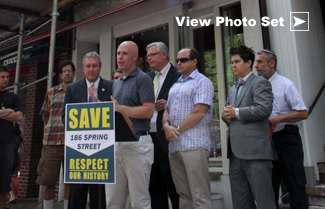 Wednesday the Greenwich Village Society for Historic Preservation was joined by openly gay elected officials State Senator Tom Duane and City Councilmember Danny Dromm, neighborhood preservationists, and leaders of prominent gay rights organizations, for a press conference calling upon the City to save 186 Spring Street from demolition. View pictures from the event here and video here. The event was also covered by AM New York, The Observer, NY Press, DNAinfo, Gay City News. Wednesday the Greenwich Village Society for Historic Preservation was joined by openly gay elected officials State Senator Tom Duane and City Councilmember Danny Dromm, neighborhood preservationists, and leaders of prominent gay rights organizations, for a press conference calling upon the City to save 186 Spring Street from demolition. View pictures from the event here and video here. The event was also covered by AM New York, The Observer, NY Press, DNAinfo, Gay City News.
 Canadian developer Stephane Boivin of Nordica bought the 1824 house at 186 Spring Street from Beastie Boy Adam Horovitz earlier this year claiming he would preserve it, but has now filed plans to demolish the historic house to make way for a new condo development. 186 Spring Street is not only significant due to its age; research conducted by GVSHP found that for years starting in the early 1970s the house served as a “gay commune” housing activists and organizations which played a profound role in in shaping the post-Stonewall gay rights movement as well as the early days of the fight against AIDS.
Residents of 186 Spring Street included:
-
Jim Owles
-
the first openly-gay candidate for public office in New York City
-
lobbied for the first gay anti-discrimination laws in NY City and State in the early 1970s, decades before they were finally enacted
-
founded the city’s first gay democratic club, Gay and Lesbian Independent Democrats, the “home club” of City Council Speaker Christine Quinn and State Senator Tom Duane
-
co-founded the Gay and Lesbian Alliance Against Defamation, now one of the nation's largest media watchdog groups
-
Dr. Bruce Voeller
-
co-founded and was the first director of the National Gay and Lesbian Task Force (NGLTF), the nation’s first national gay and lesbian advocacy organization
-
as NGLTF director, got homosexuality removed from American Psychiatric Association's list of mental disorders
-
as NGLTF director, got the federal government to ends its ban on employment of gay men and lesbians
-
won a landmark case before the U.S. Supreme Court establishing rights for gay and lesbian parents in the 1970s
-
ended the use of the stigmatizing and inaccurate term “Gay Related Immune Defense Disorder” and replaced it with “Acquired Immune Deficiency Syndrome” (AIDS) as it is now known
-
conducted the first published study establishing that condom usage can prevent the spread of AIDS
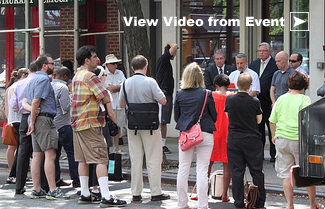 Full details of the house’s history can be found in letters from GVSHP and the National Gay and Lesbian Task Force. Full details of the house’s history can be found in letters from GVSHP and the National Gay and Lesbian Task Force.
In spite of the house’s age, its historic significance, and support for landmarking from City Council Speaker Christine Quinn, State Senator Tom Duane, and Assemblymember Deborah Glick, City Councilmember Rosie Mendez, City Councilmember Daniel Dromm, City Councilmember Jimmy Van Bramer, City Councilmember Jessica Lappin, and multiple gay rights and historic preservation organizations and hundreds of New Yorkers, the NYC Landmarks Preservation Commission (LPC) has refused to landmark the house (see letter from the LPC HERE).
Of more than 30,000 landmarked properties in New York City, the LPC has never landmarked a single one based primarily upon lesbian and gay history. Only one site in the country is recognized as a historic landmark by the federal government for its significance to lesbian and gay history, the Stonewall Inn in Greenwich Village (co-nominated by GVSHP in 1999), the site of the Stonewall Riots, considered the birthplace of the modern gay-rights movement. While recognized by the federal government, the Stonewall Inn's significance to the gay rights movement has never been recognized by New York City's own Landmarks Preservation Commission.
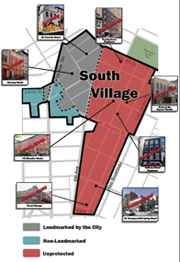
|
The proposed South Village Historic District showing landmarked and non-landmarked areas, and historic sites lost, threatened, and altered |
The house is also located within a South Village Historic District proposed by GVSHP and supported by many elected officials and community leaders. In 2009 the city promised to consider the entire proposed district for landmark designation. They have failed to keep that promise, designating only a fraction of it and allowing multiple historic buildings to be destroyed in the remainder of the neighborhood (see map HERE).
At GVSHP's request, the entire South Village, including 186 Spring Street, was determined eligible for the State and National Registers of Historic Places by the NY State Historic Preservation Office in 2007. As a result, tax credits and other financial benefits are available preserving and re-using historic properties such as 186 Spring Street. Additionally, developer Nordica also owns a larger adjacent property at 190 Spring Street which it also plans to demolish and develop, air rights from 186 Spring Street could be transferred to the other site allowing the full development potential of these properties to be realized while preserving the historic 186 Spring Street. In spite of this, the developer has thus far refused to preserve 186 Spring Street.
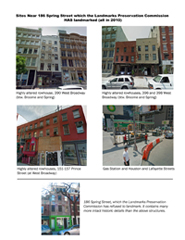
|
Sites Near 186 Spring Street which the Landmarks Preservation Commission HAS landmarked |
The Landmarks Preservation Commission claimed in its letter refusing to landmark 186 Spring Street that the building was “too highly altered” and "lacks the requisite architectural integrity” to be saved. And yet in just the last two years within just a few blocks of 186 Spring Street, the Commission has landmarked several much more highly altered buildings that are less old and with much less architectural integrity intact, as well as a gas station at the corner of Houston and Lafayette Street (see images HERE).
“It simply doesn’t pass the smell test when the Landmarks Preservation Commission will designate gas stations and much more highly altered buildings within just a few blocks of here and yet refuses to protect a building with the extraordinary history of 186 Spring Street, claiming it is “too highly altered” and “lacks architectural integrity”, said Andrew Berman, Executive Director of GVSHP.
Regarding the significance of 186 Spring Street, Berman added “the contributions this house and its residents made to shaping our culture and making our society fairer and more just are almost impossible to measure. Though it may be hard to imagine today, before the work of residents of 186 Spring Street, openly gay people could not work for the federal government, could be denied access to their children, had no protections from employment discrimination, had never run for public office in New York City, and had few if any organizations working to protect their rights and improve their lives. But the residents of this house changed all of that, and went on to fight the earliest battles against the deadly scourge of AIDS. Their contributions to improving our lives are immeasurable, and the lessons from their brave battles are as relevant today as they were forty years ago. 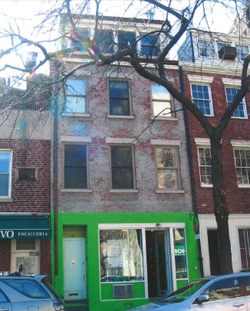 It would be truly a shame if this developer refuses to make a minor adjustment to his plans so that this house could be preserved. But it would be even more shameful if our own city government refuses to recognize the significance of this site to lesbian and gay history and refuses to act to protect it.” It would be truly a shame if this developer refuses to make a minor adjustment to his plans so that this house could be preserved. But it would be even more shameful if our own city government refuses to recognize the significance of this site to lesbian and gay history and refuses to act to protect it.”
“It is deeply disappointing to me that the Landmarks Preservation Commission has deemed 186 Spring Street unworthy of landmarking,” said New York State Senator Tom Duane. “As the first openly gay and openly HIV-positive elected official in the New York City Council and the New York State Senate, I stand on the shoulders of legendary activists who called this 1824 federal-style row house home. I would not have not been able to accomplish all that I have — and the LGBT rights movement and fight against HIV/AIDS would not have come as far as they have — were it not for the incredible work done at 186 Spring Street by Jim Owles, Arnie Kantrowitz, Bruce Voeller and others who lived here.”
“Preserving LGBT history is extremely important for future generations to understand that our movement was created on the streets of the South Village,” said Daniel Dromm, an openly-gay member of the NYC Council (Jackson Heights) and former NYC public school teacher. “A large part of the organizing that went on in the early 1970s happened at 186 Spring Street and we need to keep that building intact so that our LGBT history can be told correctly.”
“While we think it difficult to get the small minded people at the Landmarks Commission to approve this in honor of several of the people responsible for the start of the gay rights movement nationally, we think it a fight worth having. It is vital that younger people have these kind of monuments to learn about our history and struggle for civil rights and liberation. The Landmarks initial rejection of our request is proof that the struggle continues when facing hostile government bureaucrats,” said Allan Roskoff, President of the Jim Owles Liberal Democratic Club, named in honor of one of the trailblazing residents of 186 Spring Street.
“186 Spring Street is more than brick and mortar; it is a living testament to the heart and soul of LGBT activism and history in New York City," said City Councilmember Rosie Mendez, who represents the nearby East Village/Lower East Side. “This house tells an amazing and compelling story concerning the courage, fortitude, determination and formation of the LGBT movement. As one of four LGBT members of the New York City Council and a longstanding advocate within the community with manifest ties to this building and everything it stands for, I urge the Landmarks Preservation Commission (LPC) to act with all due speed to protect it for future generations,” she added.
“While we think it difficult to get the small minded people at the Landmarks Commission to approve this in honor of several of the people responsible for the start of the gay rights movement nationally, we think it a fight worth having. It is vital that younger people have these kind of monuments to learn about our history and struggle for civil rights and liberation. I worked with Jim Owles and the other inhabitants in the early 1970s and visited 186 Spring Street on a regular basis. I personally witnessed the work that transpired there and can attest to the fact that those living there have helped transform the lives of gay people throughout the world. It was from there that people learned that gay is proud and that we would no longer live in our closets. Jim was my partner and moved in with me when he left his home on Spring Street. Jim died in my arms of AIDS at St. Vincent’s Hospital in August 1993. The Landmarks Preservation Commission’s initial rejection of our request is proof that the struggle for equality continues when facing hostile government bureaucrats,” said Allen Roskoff, founder and President of the Jim Owles Liberal Democratic Club, named for his former partner Jim Owles, one of the history-making residents of 186 Spring Street.
“In 1970, when the neighborhood we now call Soho was still a struggling Industrial district, and off of practically everybody's radar, a group of pioneering and brave young gay men formed a commune in this house at 186 Spring Street. It was this same group that also rented a former Firehouse Building, just one block away at 99 Wooster Street, which became the headquarters for the Gay Activists Alliance (GAA). While all of the large public meetings and forums took place at the Firehouse, it was here, in the intimacy of this early 19th Century home, that all of the early leaders of GAA resided, and here that, interspersed with their shared household chores, they held brainstorming sessions which created the blueprint for the LGBT movement that eventually spread across the city, across the country and across the world,” said Steve Ashkinazy of the Stonewall Democratic Club, and an early member of the Gay Activists Alliance and frequent visitor to 186 Spring Street.
Find out more about 186 Spring Street HERE, the South Village HERE, and the Village’s LGBT history HERE. |